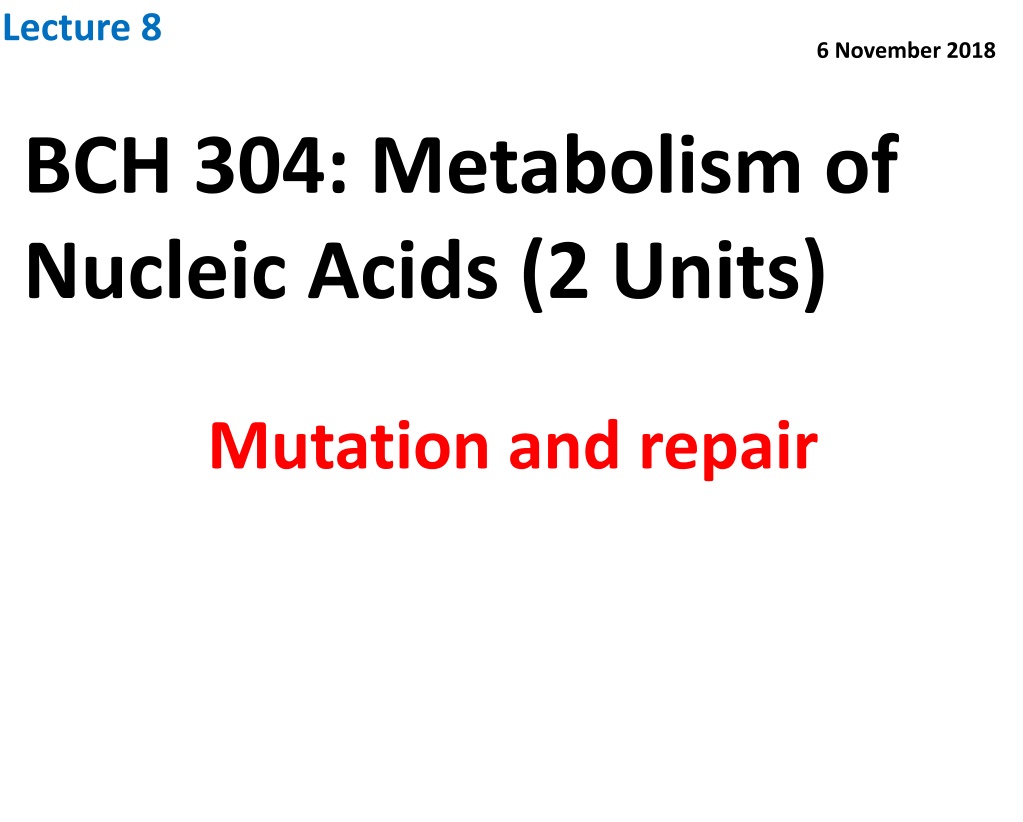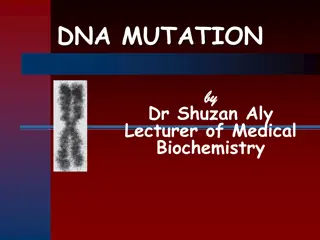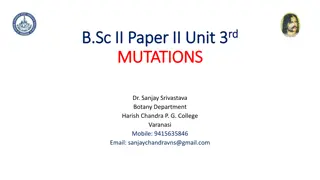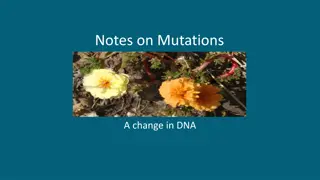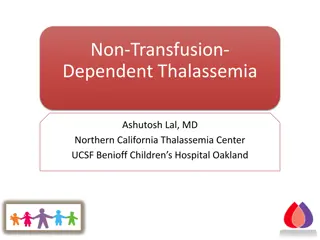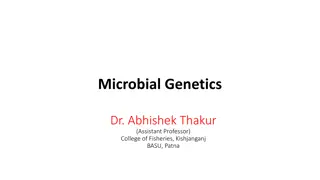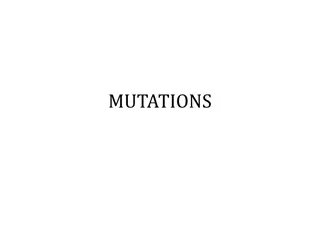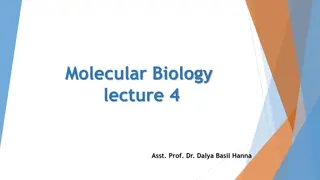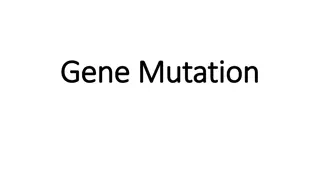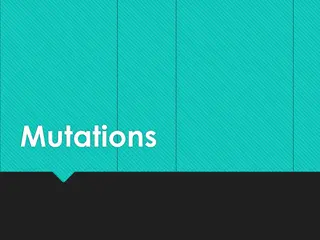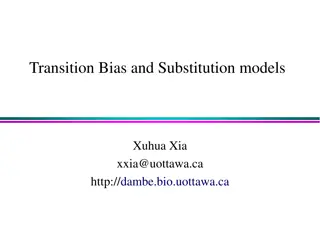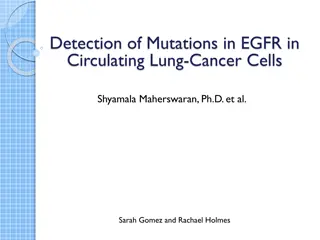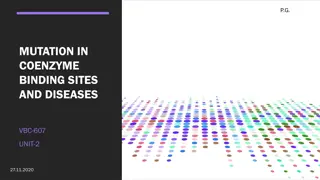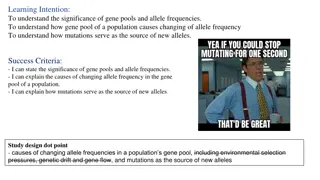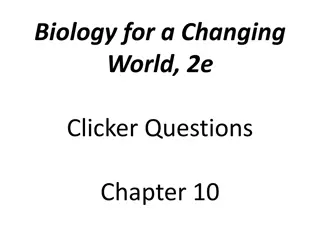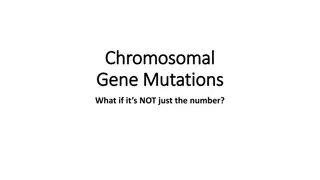Causes of Mutations and Repair Mechanisms
Mutations can be classified into spontaneous and induced mutations based on their origin. Spontaneous mutations occur naturally, while induced mutations are caused by mutagens. Understanding the causes of mutations and repair mechanisms is vital in studying genetic variation and disease development.
Download Presentation

Please find below an Image/Link to download the presentation.
The content on the website is provided AS IS for your information and personal use only. It may not be sold, licensed, or shared on other websites without obtaining consent from the author.If you encounter any issues during the download, it is possible that the publisher has removed the file from their server.
You are allowed to download the files provided on this website for personal or commercial use, subject to the condition that they are used lawfully. All files are the property of their respective owners.
The content on the website is provided AS IS for your information and personal use only. It may not be sold, licensed, or shared on other websites without obtaining consent from the author.
E N D
Presentation Transcript
Lecture 8 6 November 2018
Causes of mutation Mutation and repair Two classes of mutations are 1. Spontaneous mutations (naturally occurring) 2. Induced mutations caused by mutagens.
Causes of mutation Mutation and repair 1. Spontaneous mutations (naturally occurring) 1. Errors in replication. 2. Errors that occur during recombination events. 3. Tautomerism 4. Substitutions 5. Frame-shift mutation 6. Oxidative damage 7. Spontaneous changes
Causes of mutation Mutation and repair 1. Spontaneous mutations (naturally occurring) 1. Errors in replication If a base that is non-complementory to the template base added during replication, then a mispairing or mismatch occurs. This leads to a mutation during the next round of replication if the error is not repaired.
Causes of mutation Mutation and repair 1. Spontaneous mutations (naturally occurring) 1. Errors in replication If a base that is non-complementory to the template base added during replication, then a mispairing or mismatch occurs. This leads to a mutation during the next round of replication if the error is not repaired. 2. Errors that occur during recombination events Recombinant DNA: molecules of DNA formed by inserting portions of DNA from one organism into DNA of another.
Causes of mutation Mutation and repair 1. Spontaneous mutations (naturally occurring) 3. Tautomerism An example of a spontaneous transition results from the tautomerization 1.Adenine tautomerizes to generate a form, which can base pair with cytosine. 2.Amino group (-NH2) tautomerizes to an imino group (=NH) 3.Other tautomers can form from a keto group (-C=O) changing to an enol group (-C-OH).
Causes of mutation Mutation and repair 1. Spontaneous mutations (naturally occurring) 4. Substitutions One base is replaced by another. If this mutation occurs within the coding sequence of a gene, it may lead to the use of a different amino acid or generate a stop codon. Substitutions fall into two categories: 1.Transitions - one purine is replaced by another (A -> G or G -> A), or one pyrimidine is replaced by another (C -> T or T -> C) 2.Transversions - a purine is replaced by a pyrimidine (A -> C or T; G -> C or T), or a pyrimidine is replaced by a purine (C -> A or G; T -> A or G)
Causes of mutation Mutation and repair 1. Spontaneous mutations (naturally occurring) 5. Frameshift mutation Insertion or deletion on one strand, usually through a polymerase error when copying repeated sequences. 1.Deletions - one or more bases is removed. Unless this mutation results in the loss of a multiple of three bases, a frame-shift will occur in coding sequences, drastically altering every codon downstream of the mutation, and therefore the final amino acid composition of the protein. 2.Insertions - one or more bases is added. The effects are the same as deletions, resulting in frame-shift mutations.
Causes of mutation Mutation and repair 1. Spontaneous mutations (naturally occurring) 6. Oxidative damage Caused by oxygen radicals 7. Spontaneous changes 1. Deamination of cytosine (C) to form uracil (U). 2. Spontaneous depurination. Purines are less stable under normal cellular conditions than pyrimidines. The glycosidic bond that links purines to the sugar-phosphate backbone of DNA often is broken. If these purines are not replaced before a round of replication, any base may be added to complement the missing base during replication.
Causes of mutation Mutation and repair 2. Induced mutations 1. Chemical mutations 2. Irradiation
Causes of mutation 2. Induced mutations 1. Chemical mutations Mutation and repair 1.Non-alkylating agents 1.Formaldehyde (HCHO) reacts with amine groups and cross-linksDNA, RNA and proteins. 2.Hydroxylamine (NH2OH) specifically reacts with cytosine to form derivatives that pair with adenines instead of guanines. This change lead to a transversion (in which a purine is replaced by a pyrimidine or a pyrimidine is replaced by a purine. 3.Nitrous acid (HNO2) oxidatively deaminates cytosine, adenines, and guanines to form uracil, hypoxanthines, and xanthines respectively. These changes results in transitions in which a purine is replaced by another purine or one pyrimidine is replaced by another pyrimidine. 2. Alkylating agents These act as strong electrolytes, which become linked to many cellular nucleophiles in particular the sevenths nitrogen of the guanine in the DNA. This linkage causes breakage of DNA.
Causes of mutation Mutation and repair 2. Induced mutations 2. Irradiation 1. Ultraviolet (UV) light (200-400 nm) Induces dimerization of adjacent pyrimidines, particularly adjacent thymines. This direct mutation of DNA distorts the DNA structure, inhibits transcription, and disrupts replication until it is repaired. 2. Ionizing radiation, such as Roentgen rays (x rays) and gamma rays ( -rays) Can cause extensive damage to DNA including opening purine rings, which lead to depurination, and breaking phosphodiester bonds.
Mutation and repair Mutation rate 1.DNA has so-called hotspots, where mutations occur up to 100 times more frequently than the normal mutation rate. 2.A hotspot can be at an unusual base, e.g., 5-methylcytosine. 3.Mutation rates also vary across species. 4.Evolutionary Biologists have theorized that higher mutation rates are beneficial in some situations, because they allow organisms to evolve and therefore adapt faster to their environments.
